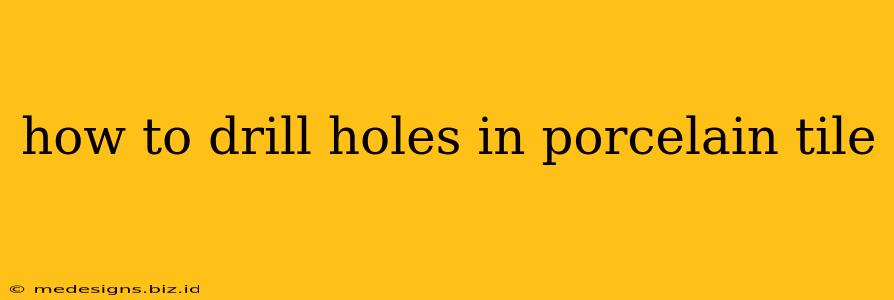Drilling holes in porcelain tile can seem daunting, but with the right tools and techniques, it's a manageable DIY project. Porcelain's hardness requires precision and the right approach to avoid cracking or chipping. This guide will walk you through the process step-by-step, ensuring a successful outcome.
Essential Tools for Drilling Porcelain Tile
Before you begin, gather the necessary tools. Using the wrong tools can lead to disaster, so investing in quality equipment is crucial. You'll need:
- A carbide-tipped masonry bit: This is essential. Standard drill bits will simply dull or break. The carbide tip is designed to withstand the hardness of porcelain. Choose a bit slightly larger than the fastener you'll be using.
- A slow-speed drill: High speeds generate excessive heat, which can cause the tile to crack. A low-speed drill (ideally a variable speed drill) provides better control and prevents damage.
- Masking tape: This helps prevent the bit from slipping and provides a more stable drilling surface.
- Safety glasses: Protect your eyes from flying debris.
- Pencil: To mark the drilling location accurately.
- Clamp (optional): For added stability, especially for larger tiles.
- Water: To keep the bit cool and lubricated during drilling. (Especially helpful with larger holes)
- Level (Optional): Ensure that your drilling location is perfectly level, especially for hanging shelves or other wall fixtures.
Choosing the Right Bit
Selecting the correct masonry bit is crucial. Look for bits specifically designed for tile and ceramic. Carbide-tipped bits are essential; avoid using cheaper alternatives. The bit's size should be slightly larger than the screw or fastener you'll be using.
Step-by-Step Guide to Drilling Porcelain Tile
Follow these steps for best results:
- Mark the Drilling Spot: Use a pencil to mark the exact location where you need the hole. Be precise!
- Secure the Tile: If possible, clamp the tile securely to a stable work surface. This minimizes movement and prevents the bit from wandering. If drilling into a wall, ensure the tile is firmly seated.
- Apply Masking Tape: Apply a piece of masking tape over the marked spot. This will help prevent the drill bit from slipping and provide a better grip. Several layers can further enhance this.
- Start Drilling Slowly: Begin drilling with the drill on a low speed. Apply gentle, even pressure. Avoid pushing too hard.
- Keep it Cool: Periodically stop drilling to let the bit cool. You can use a wet sponge or spray bottle to keep the bit and the tile cool, preventing cracking from excessive heat. (Especially important for larger holes or thicker tiles)
- Complete the Hole: Once you've broken through the top layer of the porcelain, you can slightly increase the speed, maintaining consistent pressure and keeping the bit lubricated.
- Inspect the Hole: Once finished, inspect the hole to ensure it's clean and the edges are not chipped or cracked.
Troubleshooting Common Problems
- Cracked Tile: This usually happens due to excessive pressure, high speed, or an incorrect drill bit. Always drill slowly and use a carbide-tipped masonry bit.
- Bit Slipping: Use masking tape to improve grip. Ensure the tile is securely held.
- Dull Bit: A dull bit will slip and potentially crack the tile. Use a sharp carbide-tipped bit and replace it as needed.
Tips for Success
- Practice on Scrap Tile: Before drilling your actual tile, practice on a scrap piece to get a feel for the process and the right pressure.
- Use a Drill Guide (for precise holes): A drill guide, a small tool used to align the drill bit, can help create perfectly straight holes, especially necessary for multiple holes in a line.
- Consider a Diamond-tipped hole saw (for larger holes): For larger holes, a diamond-tipped hole saw is a superior choice, offering cleaner cuts and reduced risk of cracking.
Drilling porcelain tile successfully requires patience and the right tools. By following these steps and using the correct techniques, you can achieve clean, precise holes without damaging your tile. Remember safety first, always wear safety glasses!
